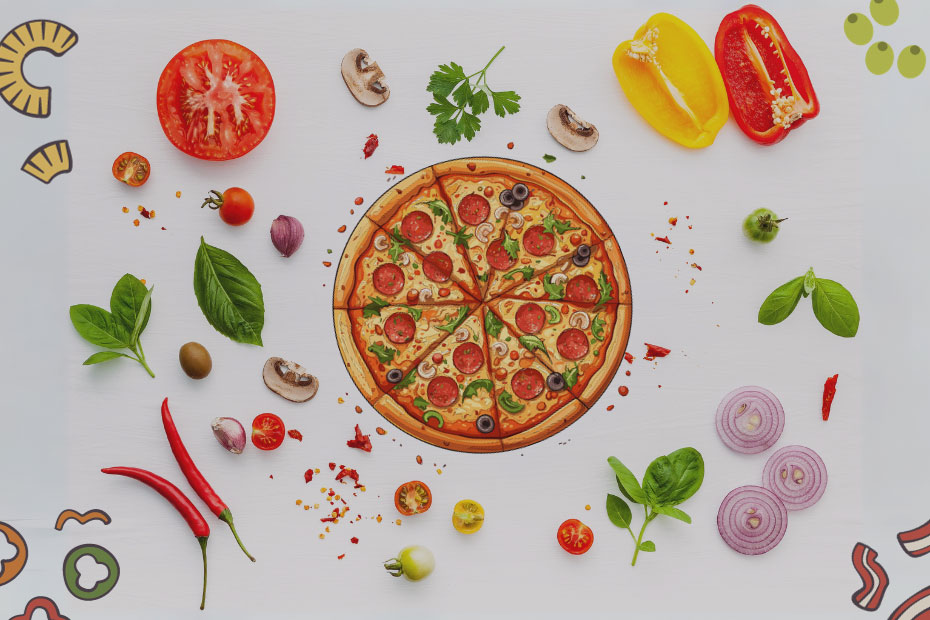Sunrise, the symbol of a new start, serenades us to seek sustenance that sparks both soul and senses. Standing at the summit of such sun-kissed selections is the letter ‘S’, spinning a spectrum of sumptuous breakfast specialties. From the simple satisfaction of scrambled eggs to the spicy sizzle of Spanish chorizo, ‘S’ sows a splendid spread spanning continents and cultures.
This article sets its sights on sailing through the sea of ‘S’-initiated breakfast stories, juxtaposing the staple with the sublime. For those scouting for a sunrise snack or stirring up a Sunday breakfast saga, let’s step together onto this scintillating sojourn. Savor the symphony of flavors, sensations, and stories stirred up by the steadfast and sensational letter “S”.
Breakfast Foods That Start With The Letter S
Sunrise and breakfast – two events that signify the start of a new day. And when it comes to breakfast, the letter ‘S’ seemingly stands out, offering a smorgasbord of sumptuous selections. From savory sensations to sweet specialties, the ‘S’ in breakfast brings a symphony of flavors to our morning table. Let’s sail through the extensive list of breakfast foods that start with this scintillating letter.
1. Scrambled Eggs
Origin: Global
Description: Beaten eggs cooked in a skillet until firm yet moist.
Serving Suggestions: With toast, bacon, or sprinkled with herbs and cheese.

2. Smoothies
Origin: Western Hemisphere, though now global.
Description: A thick beverage made from blended raw fruit, dairy products, and other ingredients like honey or oats.
Variations: Fruit smoothies, green smoothies, protein smoothies.

3. Sausages
Origin: Various across cultures.
Description: Ground meat mixed with spices, herbs, and other seasonings, then encased in a skin.
Pairings: Often enjoyed with eggs, pancakes, or as part of a full breakfast spread.

4. Scones
Origin: United Kingdom
Description: A baked goodie, often lightly sweetened and occasionally glazed.
Serving Suggestions: With clotted cream and jam, especially during an English breakfast or high tea.

5. Shakshuka
Origin: North Africa and the Middle East.
Description: Poached eggs in a spicy tomato, chili pepper, and onion sauce.
Pairings: Often scooped up with bread or pita.
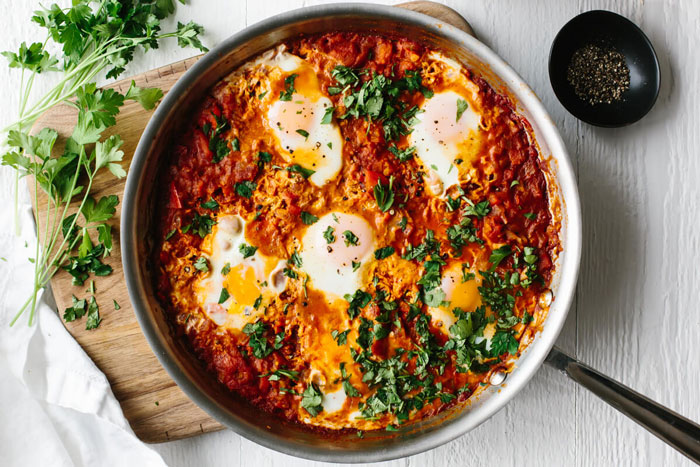
6. Syrup
Origin: Global, with maple syrup being famous in North America.
Usage: Drizzled over pancakes, waffles, and French toast.

7. Salmon (Smoked)
Origin: Northern Europe, especially Scandinavia.
Description: Cold-smoked salmon, often thinly sliced.
Serving Suggestions: On bagels with cream cheese, with scrambled eggs, or on toast.
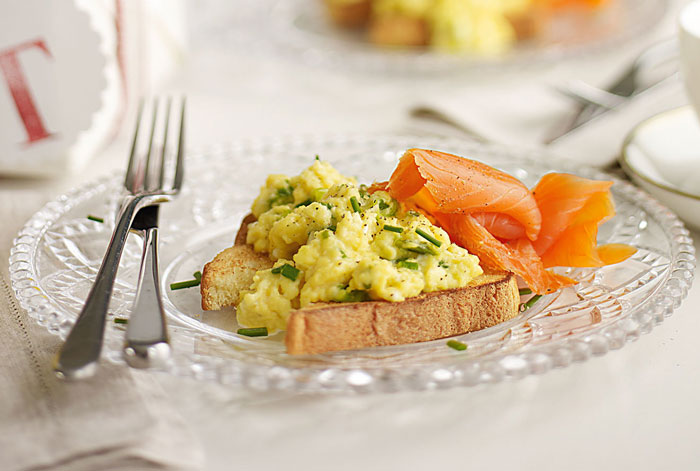
8. Steel-cut Oats
Origin: British Isles.
Description: Whole oat groats chopped into pieces. They have a chewier texture compared to rolled oats.
Serving Suggestions: As oatmeal, topped with fruits, nuts, and a drizzle of honey.
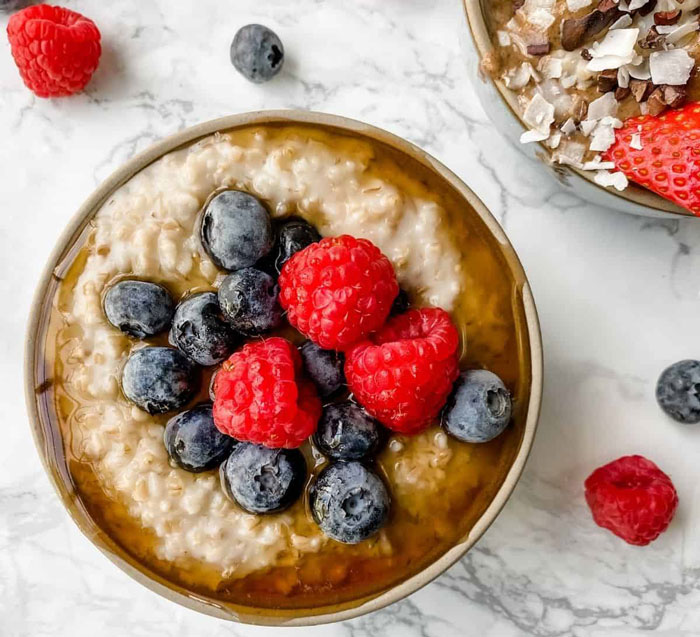
9. Strata
Origin: Italy, but popularized in the United States.
Description: A layered casserole dish, often made with bread, eggs, and cheese.
Variations: Can include vegetables, meats, and seasonings.

10. Stuffed French Toast
Origin: Evolved in the United States.
Description: French toast filled with ingredients like cream cheese, fruits, or chocolate.
Serving Suggestions: Served warm with a sprinkle of powdered sugar or syrup.

11. Skyr
Origin: Iceland.
Description: A dairy product, similar to yogurt but thicker.
Usage: Eaten plain, with fruit, or used as a spread.
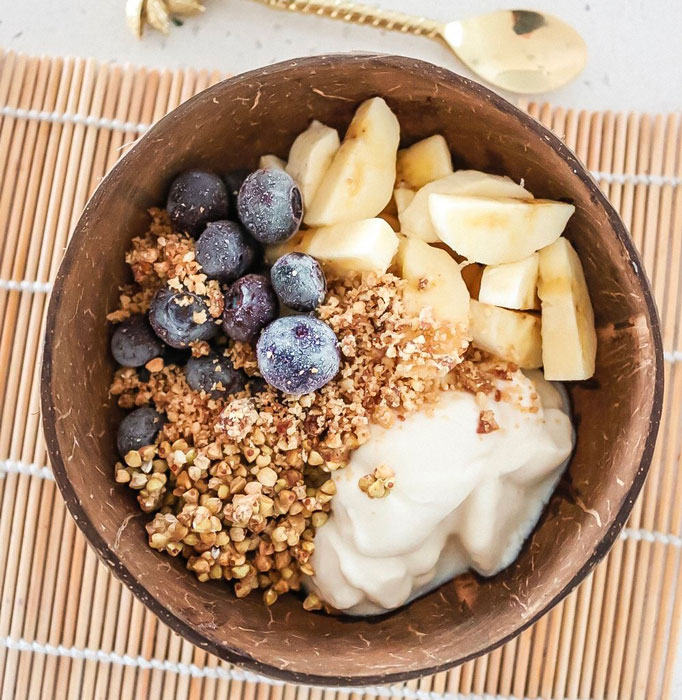
12. Sorghum Porridge
Origin: Africa.
Description: A type of porridge made from sorghum grain.
Serving Suggestions: With milk, sugar, or fruits.
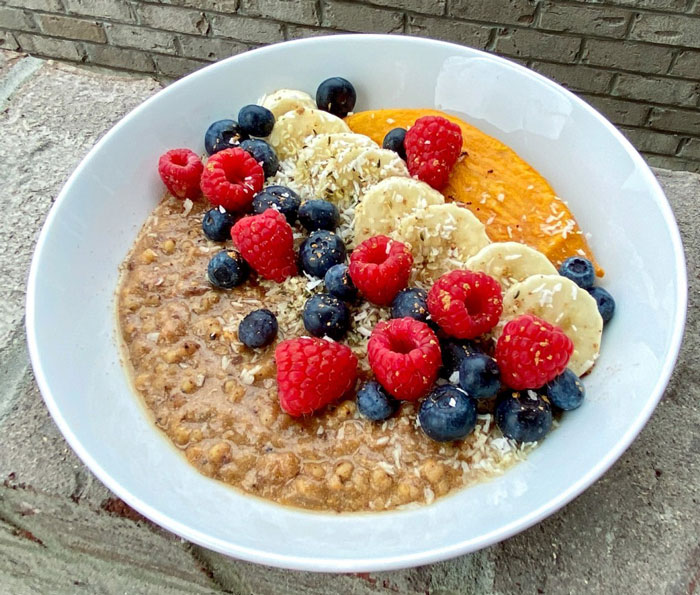
13. Sourdough Bread
Origin: Ancient Egypt but popular globally.
Description: Bread made by the fermentation of dough using naturally occurring lactobacilli and yeast.
Serving Suggestions: Toasted with butter, jam, or used for sandwiches.

14. Spinach Omelette
Origin: Global.
Description: Omelette filled with spinach, often combined with cheese or other veggies.
Health Benefit: Packed with nutrients from spinach like iron and calcium.
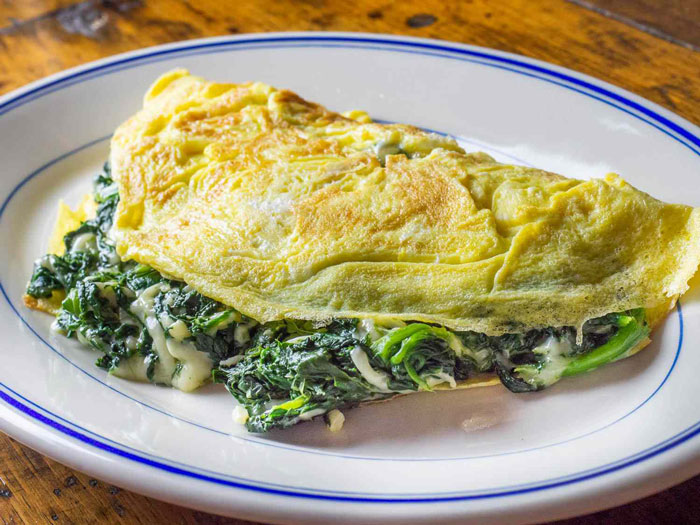
15. Sweet Potato Hash
Origin: United States.
Description: Diced sweet potatoes cooked until crispy, often mixed with bell peppers, onions, and spices.
Serving Suggestions: With poached or fried eggs on top.

16. Sabaayad
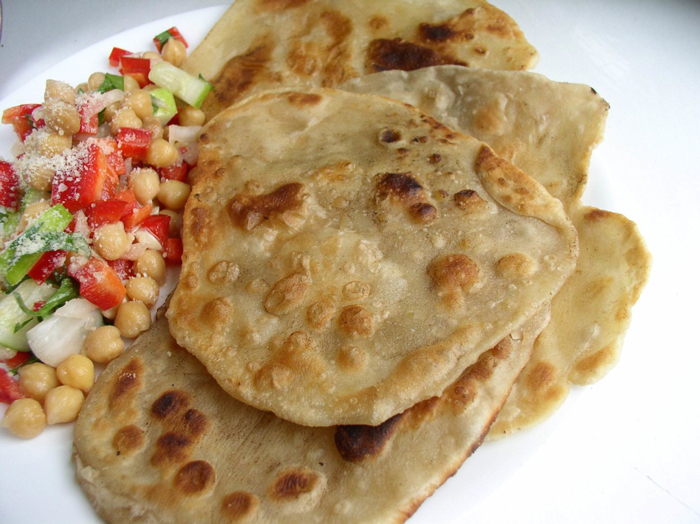
Origin: Sabaayad, also known as mohinga kawk yee, hails from Myanmar (formerly Burma). This flavorful pancake holds a special place in Burmese cuisine, traditionally enjoyed as a breakfast or snack.
Description: Imagine a savory crepe crossed with a lentil fritter. Sabaayad is made from a batter of chickpea flour, rice flour, and turmeric, seasoned with onions, garlic, and ginger. The batter is then thinly spread and pan-fried until golden brown and crispy on the edges. Topped with a vibrant mix of fresh herbs like cilantro and lemongrass, crunchy fried onions, and a squeeze of lime, sabaayad offers a delightful explosion of textures and flavors.
Breakfast Use: Sabaayad can be enjoyed on its own or paired with a dipping sauce like peanut sauce or a simple chili sauce. It can also be filled with various ingredients like stir-fried vegetables or even minced meat for a more substantial meal. For kids, sabaayad’s small size and fun textures make it a playful and engaging breakfast option. Plus, its chickpea flour base provides a good source of protein and fiber, making it a nutritious choice to start the day.
Fun Fact: Sabaayad is often sold by street vendors in Myanmar, making it a convenient and affordable breakfast option. You can also find pre-made sabaayad batter in some Asian grocery stores, allowing you to easily recreate this Burmese delicacy at home.
17. Salsa

Origin: Salsa’s roots trace back to Mexico, where it was originally a condiment made from chopped tomatoes, onions, chilies, and cilantro. Over time, salsa has evolved into a diverse array of styles and flavors, each region adding its own twist to the classic recipe.
Description: The beauty of salsa lies in its versatility. From chunky and fresh pico de gallo to smooth and smoky roasted salsa, there’s a salsa out there for every palate. Typically, salsa combines chopped tomatoes, onions, cilantro, and chilies, with additional ingredients like lime juice, garlic, and spices adding layers of complexity. The spiciness can range from mild to fiery, making it easy to find a salsa that suits your family’s preferences.
Breakfast Use: Salsa isn’t just for tacos! Its bright flavors and vibrant colors can liven up any breakfast. Scrambled eggs topped with salsa become a fiesta of textures and tastes. You can also serve salsa alongside toast, bagels, or even yogurt for a refreshing and healthy dip. For kids, salsa can be a fun way to introduce them to different vegetables and spices. Just remember to start with a mild salsa and adjust the spiciness as they develop their taste buds.
Fun Fact: Did you know that salsa is the second most popular condiment in the United States, after ketchup? This vibrant condiment has clearly captured the hearts (and taste buds) of many!
18. Salt Cod
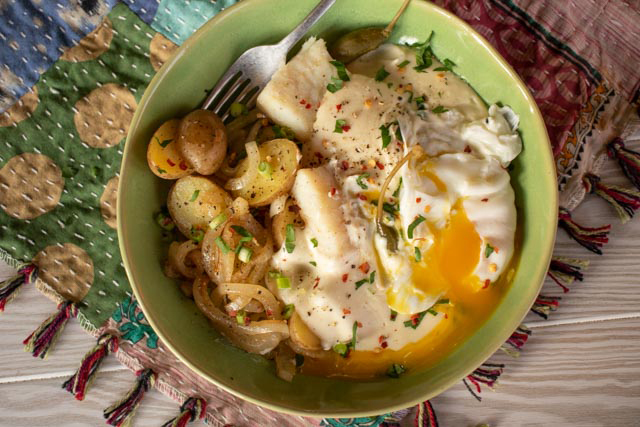
Origin: Salt cod, also known as bacalao, is a culinary tradition dating back centuries. Popular in coastal regions around the world, from Portugal and Spain to the Caribbean and Newfoundland, salt cod was developed as a way to preserve fish for long periods without refrigeration.
Description: Salt cod undergoes a unique salting and drying process that draws out moisture and inhibits bacterial growth. This results in a dense, salty fish with a concentrated flavor. While it may seem intimidating at first, salt cod is surprisingly versatile and can be transformed into a variety of delicious dishes. Soaking the fish overnight or for several hours removes excess salt and rehydrates it for cooking.
Breakfast Use: In many cultures, salt cod is a beloved breakfast staple. In Portugal, it’s often flaked and scrambled with eggs, while in the Caribbean, it might be served with boiled green bananas and avocado. Salt cod’s rich flavor and flaky texture add depth and complexity to any breakfast dish. For kids, smaller pieces of salt cod can be incorporated into frittatas or omelets, making it a fun and adventurous way to introduce them to new flavors and textures.
Fun Fact: Salt cod was once a vital food source for sailors, providing them with a source of protein and essential nutrients during long voyages. Its long shelf life and versatility made it an indispensable part of any seafaring pantry.
19. Sausage Gravy

Origin: Sausage gravy, a savory blend of sausage drippings, flour, and milk, is deeply rooted in Southern American cuisine. While its exact origins are unclear, it’s believed to have emerged from resourceful cooks using leftover sausage drippings to create a filling meal. Today, it’s a beloved breakfast staple across the South, often served atop fluffy biscuits or grits.
Description: The magic of sausage gravy lies in its simplicity. Ground sausage is cooked until lightly browned, releasing its flavorful fat. Flour is then whisked in, creating a roux that thickens the drippings. Milk is gradually added, stirring constantly until the gravy reaches a smooth and creamy consistency. Seasonings like black pepper, sage, and thyme add warmth and depth. The result is a warm, comforting blanket of rich umami flavors, ready to soak into any breakfast base.
Breakfast Use: Sausage gravy is most famously paired with buttermilk biscuits, creating a classic Southern breakfast combination. The fluffy biscuits soak up the savory gravy like sponges, offering a delightful contrast of textures. Gravy can also be served over grits, toast, or even hash browns, providing a hearty and flavorful foundation to any breakfast. For picky eaters, the familiar taste of sausage can make it a gateway to trying new textures and flavors alongside the gravy.
Fun Fact: Did you know that there are countless regional variations of sausage gravy? Some cooks add vegetables like onions or peppers, while others prefer a spicier kick with cayenne pepper or hot sauce. Encourage kids to explore these variations and discover their own favorite way to enjoy this Southern staple.
20. Scrapple
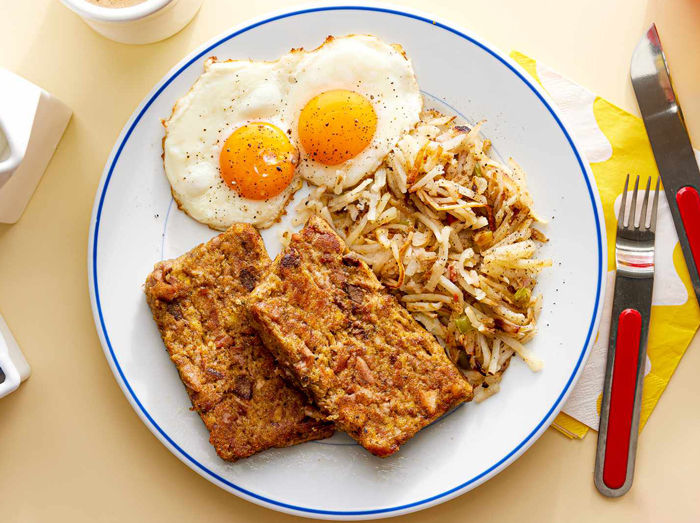
Origin: Scrapple, a unique breakfast sausage patty, hails from Pennsylvania Dutch country. Developed in the late 18th century, it was born from resourceful farmers seeking to utilize every part of the pig. Scraps of meat, pork trimmings, and buckwheat flour were combined and cooked, resulting in a hearty and flavorful patty that became a breakfast staple in the region.
Description: Scrapple’s appearance is as intriguing as its history. The dark brown, dense patty has a coarse texture thanks to the ground-up pork scraps and buckwheat flour. Don’t be fooled by its unassuming looks, though! Scrapple boasts a savory, slightly sweet flavor with a satisfyingly crispy crust when pan-fried. The buckwheat adds a subtle nutty note, making it a truly unique breakfast experience.
Breakfast Use: Scrapple is traditionally served sliced and pan-fried until golden brown and crispy. It’s often paired with eggs, toast, and apple butter for a balanced and filling breakfast. Scrapple’s crispy exterior and soft, flavorful interior make it a fun and engaging experience for kids. Additionally, its high protein content and slow-digesting nature help keep them feeling full and energized throughout the morning.
Fun Fact: Scrapple is so beloved in Pennsylvania that it was officially named the state’s official breakfast meat in 2016! Encourage kids to explore this regional treasure and learn about the resourcefulness and culinary ingenuity of the Pennsylvania Dutch people.
21. Shrimp and Grits
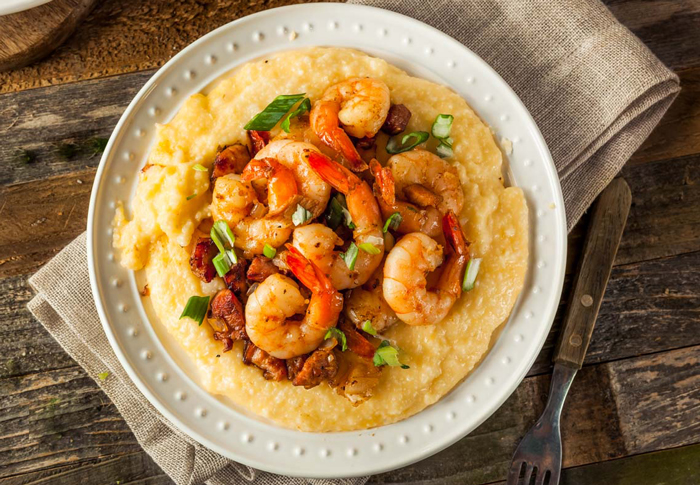
Origin: Shrimp and grits, a delightful marriage of coastal and Southern flavors, emerged in the Lowcountry regions of the United States. Freshly caught shrimp were combined with creamy grits, creating a dish that showcased the bounty of the sea and the comforting richness of Southern cuisine. Today, it’s a popular breakfast and brunch option across the country, offering a taste of Southern hospitality.
Description: Picture plump, juicy shrimp cooked in a flavorful sauce of garlic, paprika, and cayenne pepper, nestled atop a bed of steaming, creamy grits. The shrimp’s sweet, briny flavor contrasts beautifully with the grits’ richness, while the spicy sauce adds a touch of heat and complexity. Every bite is a celebration of textures, with the soft grits yielding to the tender shrimp and the occasional crunch of chopped vegetables.
Breakfast Use: Shrimp and grits can be enjoyed on their own or dressed up with additional toppings like crumbled bacon, sautéed peppers and onions, or a poached egg. Its versatility makes it suitable for adventurous eaters and picky palates alike. Plus, the protein from the shrimp and the complex carbohydrates from the grits provide a balanced and energy-boosting start to the day.
Fun Fact: Did you know that grits were originally a Native American dish made from pounded corn? European settlers adopted the dish and added their own twist, leading to the creamy grits we know and love today. Share this bit of history with kids and encourage them to appreciate the cultural fusion that created this delicious breakfast combination.
22. Silog
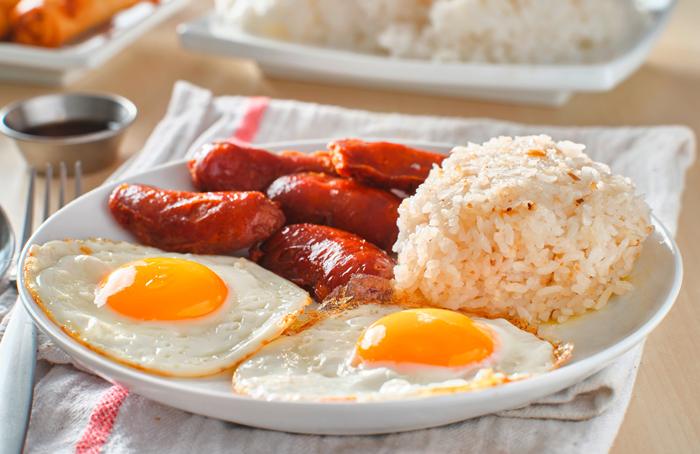
Origin: Silog, a portmanteau of “sinangag” (fried garlic rice) and “itlog” (egg), is a beloved Filipino breakfast dish. Its origins can be traced back to the early 20th century, when it emerged as a quick and filling meal for busy workers and students. Today, silog has exploded in variety, with countless options featuring different meats and proteins alongside the classic garlic rice and egg.
Description: The beauty of silog lies in its adaptability. At its core, it’s a blank canvas for culinary creativity. The garlic rice, fragrant with toasted garlic and aromatics, serves as a comforting base. The egg, cooked sunny-side up or scrambled, adds richness and creaminess. But the true star of the show is the chosen protein. From savory tapa (cured beef) and longganisa (sweet sausage) to crispy tocino (cured pork) and flaky bangus (milkfish), the options are endless. Each variation boasts its own unique flavor profile, ensuring there’s a silog out there for every palate.
Breakfast Use: Silog’s versatility makes it perfect for any breakfast occasion. It’s a hearty and satisfying option for busy mornings, while its diverse flavors cater to both adventurous and picky eaters. Serve it with fresh tomatoes, cucumber slices, and a side of spicy vinegar for a complete and invigorating breakfast experience. Encourage kids to explore the different silog varieties and discover their own favorites, learning about Filipino culture and flavors along the way.
Fun Fact: Did you know that there are over 100 different types of silog? From classic longganisa silog to more recent creations like kare-kare silog and sisig silog, the possibilities are truly endless. Encourage kids to research and try different silog combinations, making breakfast a fun and educational adventure.
23. Sizzlean
Origin: Sizzlean, a savory South African toast topped with a melty cheese and meat mixture, is a breakfast staple in many households. Its roots trace back to the Dutch settlers who brought their love for open-faced sandwiches to the Cape region. Over time, Sizzlean evolved into a uniquely South African dish, incorporating local ingredients and flavors.
Description: Imagine a thick slice of toasted bread generously spread with butter or margarine. On top sits a warm, gooey blanket of melted cheddar cheese, often studded with savory bits of meat. Popular choices include boerewors (a seasoned sausage), bacon, or even chopped leftover braai (barbecue) meat. The finishing touch? A scattering of chopped tomato and onion, adding freshness and a touch of acidity. Each bite of Sizzlean is an explosion of textures and flavors, with the crispy bread giving way to the creamy cheese and the flavorful meat.
Breakfast Use: Sizzlean is a quick and easy breakfast option, perfect for busy mornings. It’s also incredibly versatile. Experiment with different types of bread, cheeses, and meats to suit your taste preferences. Add a fried egg for extra protein, or serve it alongside fresh fruit and yogurt for a balanced meal. Sizzlean’s familiar flavors and textures make it a great way to introduce kids to South African cuisine, sparking their curiosity about different cultures and culinary traditions.
Fun Fact: The name “Sizzlean” is believed to be onomatopoeic, mimicking the sound of the cheese and meat sizzling as it cooks on the toast. Encourage kids to listen for the sizzle as they prepare their own Sizzlean, making breakfast a fun and sensory experience.
24. Snacking for Breakfast

Origin: While often viewed as a between-meal treat, snacking has long been embraced as a breakfast option in many cultures around the world. From the small plates of dim sum in China to the tapas-style breakfast in Spain, snacking offers a fun and engaging way to start the day.
Description: The beauty of snacking for breakfast lies in its flexibility. It allows you to break away from the traditional three-course format and embrace a more playful and personalized approach. Think of it as a culinary adventure, sampling different flavors and textures from around the world. In Japan, bite-sized onigiri rice balls and miso soup make for a light and flavorful breakfast. In Mexico, chilaquiles – crispy tortilla strips bathed in salsa – offer a spicy and satisfying start to the day. And in India, dosa crepes filled with savory potato masala are a popular street food enjoyed throughout the morning.
Breakfast Use: Snacking for breakfast can be a great way to cater to picky eaters or those with smaller appetites.
25. Sopaipillas
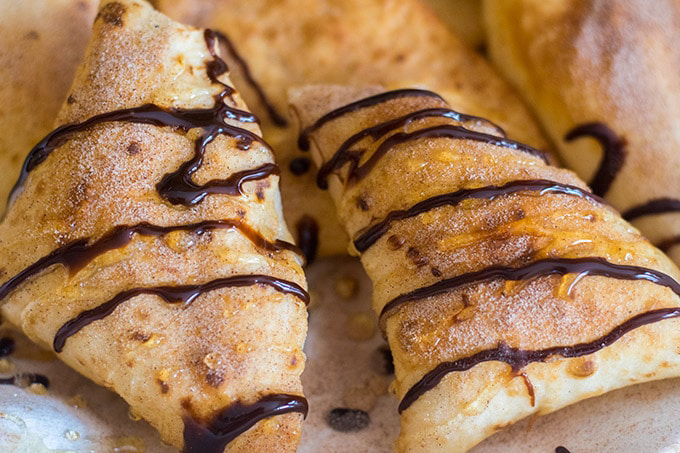
Origin: Sopaipillas, golden pillows of fried dough, hail from the Southwestern United States and Northern Mexico. Their roots can be traced back to Spanish conquistadors who brought their love for fritters to the region. Over time, sopapillas evolved into a beloved comfort food, often enjoyed at breakfast, alongside meals, or as a sweet treat.
Description: Imagine biting into a warm, airy cloud of dough. That’s the magic of sopapillas. Made with simple ingredients like flour, baking powder, salt, and milk, the dough is fried until golden brown and puffed up. The result is a light and crispy exterior giving way to a soft and fluffy interior. Sopaipillas can be enjoyed plain, dusted with cinnamon sugar, drizzled with honey or syrup, or even topped with savory ingredients like cheese and beans.
Breakfast Use: Sopaipillas offer a delightful and versatile breakfast option. Their neutral flavor pairs beautifully with sweet or savory toppings. Serve them alongside scrambled eggs and salsa for a hearty and flavorful meal. Dip them in honey or maple syrup for a sweet treat. Or get creative and fill them with scrambled eggs, chorizo, or cheese for a fun and portable breakfast. Sopaipillas’ playful texture and versatility make them a hit with kids, encouraging them to explore different flavors and culinary traditions.
Fun Fact: Did you know that sopapillas are often served during holidays and celebrations in the Southwest? Their puffy appearance is said to symbolize prosperity and good luck. Share this bit of cultural significance with kids and make breakfast a time to learn and celebrate.
26. Soufflé

Origin: Soufflé, a light and airy baked dish, boasts a rich history dating back to 18th-century France. While early versions were savory, it was Antonin Carême, a renowned French chef, who perfected the light and fluffy soufflé we know today. Soufflé became a symbol of culinary artistry, its delicate nature requiring skill and precision to achieve its signature rise.
Description: Imagine biting into a cloud of pure flavor. That’s the essence of a perfectly prepared soufflé. Made with a base of eggs, flour, and milk, soufflé relies on trapped air for its impressive rise. The addition of cheese, vegetables, or even chocolate creates the desired flavor. Baking at high temperatures allows the egg whites to expand, creating a light and airy structure that melts in your mouth. Each bite is a delightful dance of textures, with the crisp exterior giving way to a soft and flavorful interior.
Breakfast Use: While traditionally enjoyed as a main course or dessert, soufflé can be a surprisingly elegant and impressive breakfast option. Cheese soufflé is a classic choice, offering a savory and satisfying start to the day. For a touch of sweetness, try a souffle infused with fruit or topped with a dollop of jam. Soufflé’s delicate nature makes it a fun culinary experiment for older children, teaching them about precision and the science behind food.
Fun Fact: The name “soufflé” comes from the French verb “souffler,” meaning “to blow” or “to puff.” This perfectly describes the magical rise of this light and airy dish. Share this bit of etymology with kids and spark their curiosity about the language of food.
27. Soy Sauce

Origin: Soy sauce, a dark, umami-rich condiment, boasts a history spanning centuries in China. Made from fermented soybeans, wheat, and salt, it was originally used as a way to preserve food and add flavor. Over time, soy sauce became a staple ingredient in Asian cuisine, revered for its depth and versatility.
Description: Soy sauce doesn’t scream “breakfast food” at first glance. But don’t underestimate its transformative power! Just a few drops can add a touch of savory magic to countless breakfast dishes. Scrambled eggs become richer and more complex with a splash of soy sauce. Tofu scrambles gain a meaty depth with a soy sauce glaze. Even fried rice comes alive with a drizzle of this umami-rich condiment.
Breakfast Use: Soy sauce isn’t just for Asian-inspired breakfasts. Experiment with adding it to your usual dishes and discover its versatility. A few drops in oatmeal add a surprising twist, while a soy sauce marinade takes pancakes to the next level. And for a fun and educational adventure, introduce kids to different Asian breakfast traditions like Japanese tamagoyaki (rolled omelette) or Korean bibimbap, both of which utilize soy sauce for depth and flavor.
28. Steak and Eggs
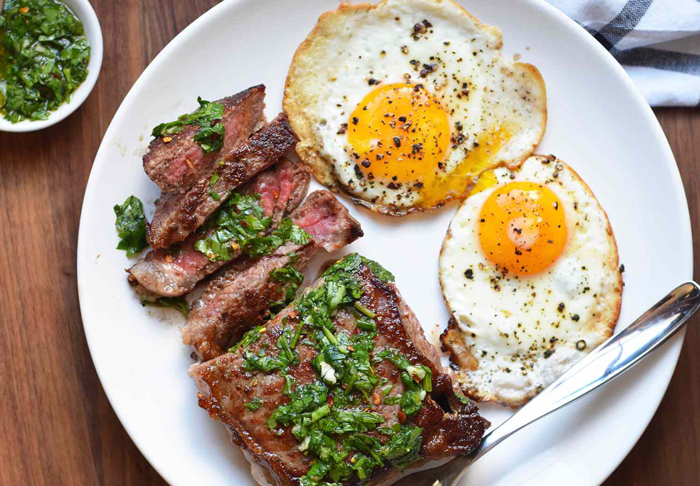
Origin: Steak and eggs, a classic American breakfast combination, boasts a rich history intertwined with the country’s frontier spirit. Cowboys and ranchers, fueling their days with long hours and hard work, needed a hearty meal to start their mornings. Steak, readily available from their herds, and eggs, a convenient source of protein, became a natural pairing, evolving into a beloved tradition.
Description: Picture a sizzling steak, cooked to your liking, alongside a plate of fluffy scrambled eggs. The aroma of grilled meat mingles with the buttery richness of the eggs, creating an irresistible breakfast symphony. Each bite is a satisfying contrast of textures – the tender steak yielding to the soft, pillowy eggs. The savory notes of the meat are balanced by the slight creaminess of the eggs, creating a perfect harmony of flavors.
Breakfast Use: Steak and eggs are more than just a hearty breakfast; they’re an experience. Gather around the table and enjoy the sizzle of the steak, the crack of the eggs, and the anticipation of the first bite. This classic combination is a great way to introduce kids to different cooking techniques and the importance of protein in a balanced breakfast. Plus, it’s easily customizable! Add a side of toast for dipping, sauteed vegetables for color and nutrients, or even a dollop of hollandaise sauce for a touch of decadence.
Fun Fact: Did you know that steak and eggs are often associated with the Wild West? Movies and TV shows have cemented this image, making it a breakfast choice that sparks imagination and transports kids to the days of cowboys and cattle drives.
29. Strawberries

Origin: Strawberries, those vibrant red jewels of the fruit world, are believed to have originated in Europe, with their cultivation dating back to Roman times. Prized for their sweet flavor and vibrant color, strawberries quickly spread across the globe, becoming a beloved breakfast staple in many cultures.
Description: Imagine biting into a juicy strawberry. The burst of sweetness on your tongue is followed by a subtle tang and a refreshing aroma. Each bite is a celebration of summer, with the bright red color offering a visual feast alongside the explosion of flavor. Strawberries are not just delicious; they’re also packed with vitamins and antioxidants, making them a healthy and nutritious way to start the day.
Breakfast Use: Strawberries’ versatility shines on the breakfast table. Enjoy them sliced on top of yogurt or cereal, adding a pop of sweetness and color. Blend them into smoothies for a refreshing and nutrient-packed drink. Or, for a fun and interactive breakfast, let kids create their own strawberry masterpieces. Thread them onto skewers with other fruits, make a fruit salad, or even whip up a simple strawberry jam for topping toast or pancakes.
Fun Fact: Did you know that strawberries aren’t actually berries? They are classified as aggregate accessory fruits, meaning that the fleshy part we eat is formed from the swollen receptacle of the flower, not the ovary itself. This fun fact is a great way to spark curiosity and encourage kids to learn more about the science behind fruits.
30. Syrup and Pancakes

Origin: Pancakes, those fluffy discs of batter joy, have been enjoyed for centuries across cultures. From the Greek “plakous” to the Russian “blin,” pancakes have taken on countless forms and flavors, united by their simple ingredients and satisfying taste. Syrup, the sweet nectar that adorns these fluffy stacks, adds a touch of decadence and variety.
Description: Imagine a warm, golden pancake, its surface dotted with bubbles and ridges from the griddle. A generous drizzle of syrup bathes the surface, creating a sticky, glistening sheen. The first bite is a delightful blend of textures – the fluffy pancake yielding to the smooth syrup, each mouthful a symphony of sweet and soft. Pancakes and syrup offer a blank canvas for creativity. Add chocolate chips, blueberries, or even savory toppings like cheese and herbs to personalize your stack.
Breakfast Use: Pancakes and syrup are more than just a breakfast staple; they’re a ritual. Gather around the griddle, making pancakes together and watching them bubble and brown. Experiment with different toppings and flavors, creating a unique breakfast experience every morning. Plus, pancakes are a great way to introduce kids to cooking and baking, teaching them basic skills and the joy of creating something delicious.
Fun Fact: Did you know that the world’s largest pancake was made in Rochdale, England, in 1994? It measured 49 feet (15 meters) in diameter and weighed over 3 tons! Share this fun fact with kids and spark their imagination about the possibilities of pancakes.
List of Breakfast Foods Starting with S
| Sabaayad | Salmon | Salmon Bagel |
| Salsa | Salsa Roja | Salsa Verde |
| Salt Cod | Sandia | Sandwich |
| Satti | Sausage | Sausage Gravy |
| Scone | Scrambled Eggs | Scrapple |
| Shakes | Shaobing | Shengjian Mantou |
| Shrimp And Grits | Side Dish | Silog |
| Simit | Sizzlean | Slinger |
| Smoothies | Snacks | Soft-Boiled Eggs |
| Sopaipillas | Sopapillas | Souffle |
| Sourdough Bread | Soy Sauce | Spinach |
| Stamp And Go | Staple | Steak And Eggs |
| Sticky Bun | Strata | Strawberries |
| Strawberry | Strawberry Jam | Strawberry Smoothie |
| Strudel | Sugar | Sugar Puffs |
| Suhur | Sunflower Seeds | Sunnyside Up Eggs |
| Sweet Potatoes | Syrniki | Syrup |
| Syrup And Pancakes |
Conclusion
Breakfast is often considered the cornerstone meal of the day, setting the tone for what lies ahead. And the spectacular spread of ‘S’-initiated foods ensures that every morning can be a savory, sweet, or spicy surprise, suiting the palate of each individual. Whether you’re in the mood for the simple satisfaction of scrambled eggs or the spicy sensations of shakshuka, the ‘S’ foods offer a splendid start. So, savor the symphony of ‘S’ and start your day on a sensational note!
Breakfast Foods That Start With
A | B | C | D | E | F | G | H | I | J | K | L | M | N | O | P | Q | R | S | T | U | V | W | X | Y | Z

